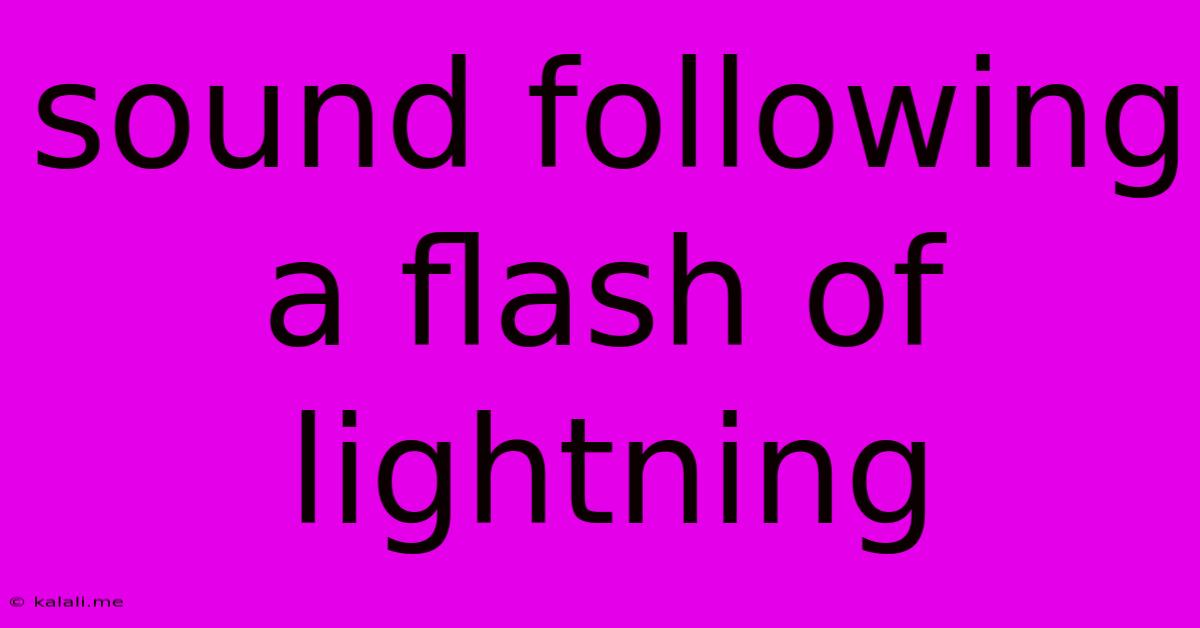Sound Following A Flash Of Lightning
Kalali
Jun 12, 2025 · 3 min read

Table of Contents
The Crack of Thunder: Understanding the Physics Behind Sound Following Lightning
Ever been caught in a thunderstorm, mesmerized by the almost instantaneous flash of lightning followed by the rumbling boom of thunder? This seemingly simultaneous event is a fascinating demonstration of the fundamental difference between the speed of light and the speed of sound. This article will explore the physics behind this phenomenon, explaining why we see the lightning before we hear the thunder, and how the distance between us and the lightning strike influences the sound we perceive.
Understanding the Speed Difference:
The key to understanding this lies in the stark difference in the speeds of light and sound. Light travels at approximately 299,792 kilometers per second (186,282 miles per second), while the speed of sound in air is considerably slower, around 343 meters per second (767 miles per hour) at room temperature. This significant discrepancy means light reaches our eyes virtually instantaneously, while sound takes a measurable amount of time to travel the same distance.
Calculating the Distance:
The delay between the lightning flash and the thunderclap can be used to estimate the distance of the lightning strike. A simple rule of thumb is to count the seconds between seeing the flash and hearing the thunder, then divide by five (or three, for a more precise calculation accounting for atmospheric conditions). The result provides an approximate distance in kilometers (or miles). This is because sound travels approximately one kilometer in three seconds or one mile in five seconds.
The Nature of Thunder:
Thunder itself isn't a single, sharp crack; it's a complex sound created by the rapid expansion of air heated to incredibly high temperatures by the lightning bolt. This superheated air expands explosively, creating a shock wave that propagates outwards. The rumbling we hear is often a series of shock waves reflecting off different atmospheric layers and objects on the ground, creating a prolonged and multifaceted sound.
Factors Affecting Thunder's Sound:
Several factors influence how we perceive thunder:
- Distance: Closer lightning strikes produce louder, sharper sounds, while distant strikes result in fainter, more prolonged rumbles.
- Atmospheric Conditions: Temperature, humidity, and wind speed can all affect the speed and direction of sound waves, influencing the intensity and character of the thunder.
- Terrain: The surrounding landscape plays a significant role. Hills and buildings can reflect and refract sound waves, modifying the sound we hear.
Beyond the Basics: Lightning Safety:
Understanding the relationship between lightning and thunder is not just an interesting scientific phenomenon; it's crucial for safety. The delay between the flash and the boom allows you to gauge the distance of the storm and take appropriate safety precautions. If you hear thunder, even a distant rumble, seek shelter immediately. Lightning is a dangerous force of nature, and understanding its associated sounds is an important step in protecting yourself and others.
Conclusion:
The crack of thunder following a flash of lightning is a clear illustration of the differing speeds of light and sound. By understanding this fundamental physics, we can not only appreciate the natural wonder of a thunderstorm but also ensure our safety during these powerful weather events. Remember to always prioritize safety when thunderstorms are near.
Latest Posts
Latest Posts
-
What Is The Source Of Almost All Energy On Earth
Jun 13, 2025
-
Letter To Embassy For Visa Request
Jun 13, 2025
-
Which Of The Following Is An Observation
Jun 13, 2025
-
Find The Radius Of Convergence Calculator
Jun 13, 2025
-
Specific Weight Of Water In Si Unit
Jun 13, 2025
Related Post
Thank you for visiting our website which covers about Sound Following A Flash Of Lightning . We hope the information provided has been useful to you. Feel free to contact us if you have any questions or need further assistance. See you next time and don't miss to bookmark.